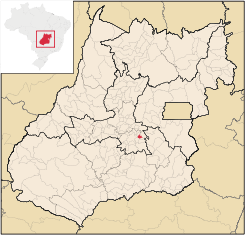
Bonfinópolis
Encyclopedia
| Bonfinópolis | |
|---|---|
| State | Goiás Goiás Goiás is a state of Brazil, located in the central part of the country. The name Goiás comes from the name of an indigenous community... |
| Area: | 122.2 km² |
| Population: | 6,744 (IBGE 2007) |
| Elevation: | 948 m above sea level |
| Postcode (CEP): | 75195-000 |
| Became a city: | 1889 |
| Distance to Goiânia Goiânia -Climate:The city has a tropical wet and dry climate with an average temperature of . There's a wet season, from October to April, and a dry one, from May to September. Annual rainfall is around 1,520 mm.... : |
33 km. |
| IBGE statistical microregion: | Goiânia Microregion Goiânia Microregion The Goiânia Microregion is a region in central Goiás state, Brazil. It includes 17 municipalities with a population of 2,032,305 in a total area of 6,848.00 km².... |
| Website: | none |

Town
A town is a human settlement larger than a village but smaller than a city. The size a settlement must be in order to be called a "town" varies considerably in different parts of the world, so that, for example, many American "small towns" seem to British people to be no more than villages, while...
and municipality
Municipality
A municipality is essentially an urban administrative division having corporate status and usually powers of self-government. It can also be used to mean the governing body of a municipality. A municipality is a general-purpose administrative subdivision, as opposed to a special-purpose district...
in central Goiás
Goiás
Goiás is a state of Brazil, located in the central part of the country. The name Goiás comes from the name of an indigenous community...
state, Brazil
Brazil
Brazil , officially the Federative Republic of Brazil , is the largest country in South America. It is the world's fifth largest country, both by geographical area and by population with over 192 million people...
. It is located a short distance east of Goiânia
Goiânia
-Climate:The city has a tropical wet and dry climate with an average temperature of . There's a wet season, from October to April, and a dry one, from May to September. Annual rainfall is around 1,520 mm....
and is part of the Goiânia metropolitan area.
The distance to Goiânia
Goiânia
-Climate:The city has a tropical wet and dry climate with an average temperature of . There's a wet season, from October to April, and a dry one, from May to September. Annual rainfall is around 1,520 mm....
is 33 km. and connections are made by BR-457 / GO-010.
Neighboring municipalities are:
- north: GoianápolisGoianápolisGoianápolis is a small town and municipality in central Goiás state, Brazil. It had a population of 11,159 in a total area of 162.38 km²...
- south: Senador CanedoSenador CanedoSenador Canedo is a city and municipality in central Goiás state, Brazil. It is the center of the petrochemical industry for the state.-Location:Senador Canedo is crossed by two state highways, GOs 020 and 010...
and CaldazinhaCaldazinhaCaldazinha is a small town and municipality in central Goiás state, Brazil. The population was 3,157 in a total area of 312 km².Located 27 kilometers from the state capital, Goiânia, Caldazinha belongs to the Goiânia Microregion... - east: Leopoldo de BulhõesLeopoldo de BulhõesLeopoldo de Bulhões is a small town and municipality in central Goiás state, Brazil. The total area was 495.0 km² in October 2002) and the population was 8,916 in 2007...
- west: GoiâniaGoiânia-Climate:The city has a tropical wet and dry climate with an average temperature of . There's a wet season, from October to April, and a dry one, from May to September. Annual rainfall is around 1,520 mm....
Population and Political Data
- Population density in 2007: 55.16 inhab/km²
- Population growth rate from 2001-2007: 3.35.%
- Population in 1980: 3,324
- Population in 1991: 4,303
- Urban population in 2007: 6,167
- Rural population in 2007: 577
- Eligible voters in 12/2007: 5,764
- City government: mayor (Antônio das Graças Filho), vice-mayor (Lázaro da Silva Borges), and 09 councilpersons
Economy
The economy is based on cattle raising (11800 head in 2006), milk production, agriculture, commerce, public administration, and small transformation industries. There was modest production of oranges, coffee, manioc, rice, and tomatoes.(IBGE 2006)
Health
- infant mortality in 2000: 27.7
- infant mortality in 1990: 28.5
- hospitals: 01 (2007)
- hospital beds: 20
- doctors / nurses / dentists in the public system: 08 / 01 / 0 (2002)
Education
- literacy rate in 2000: 85.5
- literacy rate in 1991: 74.0
- school enrollment in 2006: 2,016 in 4 schools
(IBGE 2006)
- HDI: 0.723
- State ranking: 163 out of 242 municipalities
- National ranking: 2,557 out of 5,507 municipalities
For the complete list see http://www.frigoletto.com.br/GeoEcon/idhgo.htm

